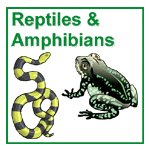
Reptile Info-File |
|
Snakes, lizards, turtles, alligators, and crocodiles are all reptiles. Often people are apprehensive about reptiles. In fact once you familiarize yourself with the many different species of reptiles and improve your identification skill, you will become fascinated by them. Reptiles are ectotherms (cold-blooded); their body temperatures fluctuate with environmental temperatures. Because of this characteristic, reptiles are often seen on exposed rocks or blacktop sunning themselves, absorbing heat from the environment. Therefore, the best time to look for reptiles on most sites is in the middle of the day. Identify snakes and lizards by coloration, patterns, size, and behavior. Identify turtles by shellshape, size, coloration, habitat, and behavior. Usually land tortoises have domed shells, hard undersides, and are able to pull their heads inside their shells. Water turtles cannot retreat inside their shell. Like all wild animals, reptiles do not like to be surprised or handled by humans. Although many snakes and lizards are poisonous, some snakes and lizards, and many turtles are safe to handle and examine. Before approaching a reptile, though, make sure you know what it is and that it is safe to handle. If you are unsure of the exact species you have found, it is usually best to view the species from a safe distance and retreat slowly. Most reptiles lay leathery eggs on land. If you see any eggs on our site, do not disturb them but do try to identify them by size, number, and location. Info-Links
|
 |
| [Search!] | [Survey] [Planning] [Projects] [Outreach] | [What's New!] |
|
Copyright � 1999-2000, REWHC. All Rights Reserved 4270 have visited | ||